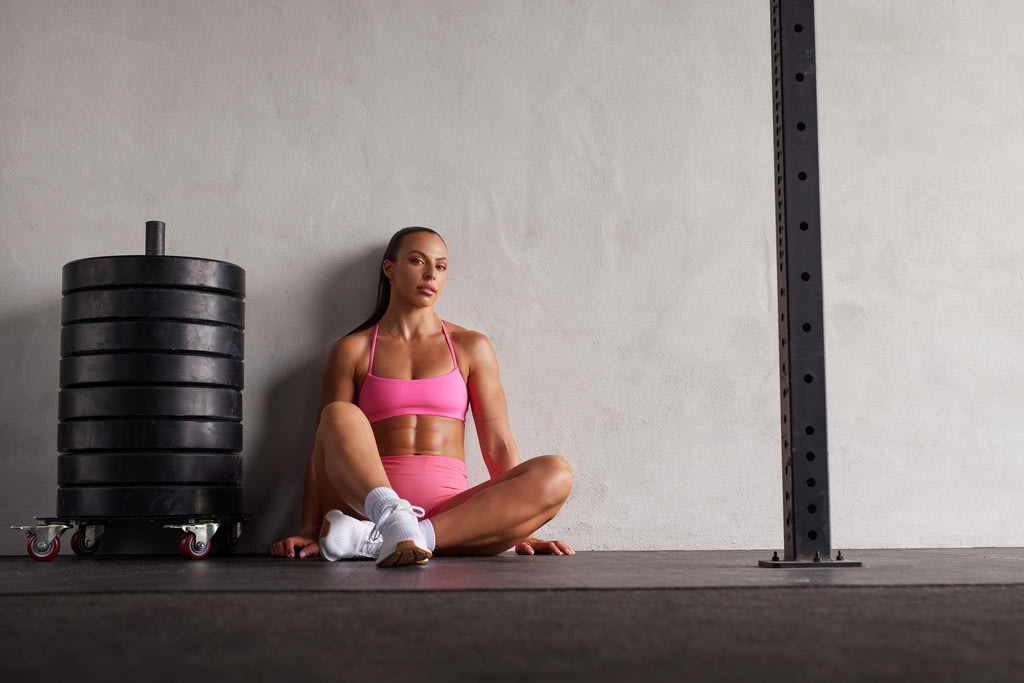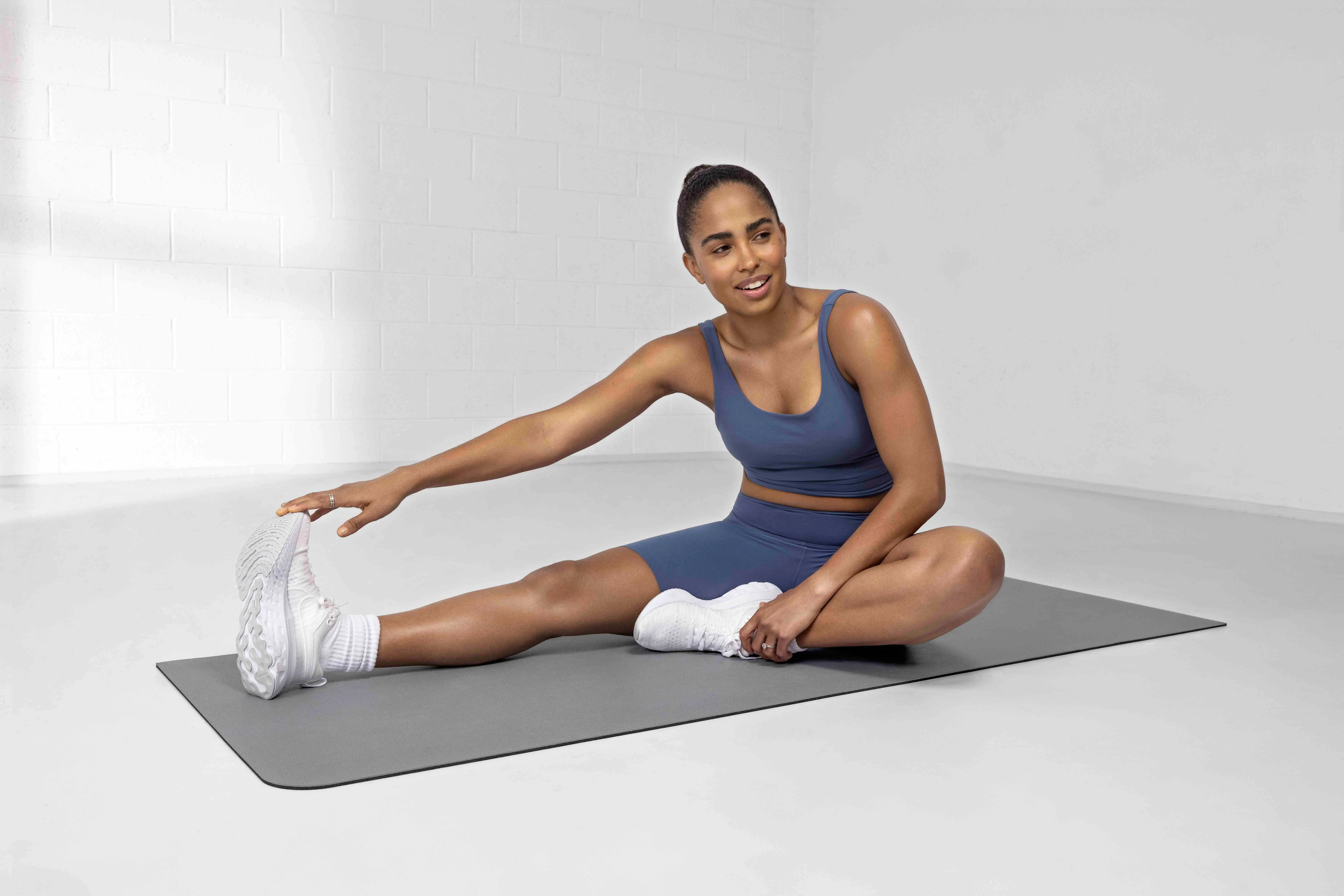17 Effective Ways To Speed Up Muscle Recovery
Here are some proven tips to ease those aches and help you get back to your training sooner.

October 4, 2019 - Updated June 19, 2025

If you’ve been levelling up your workouts, trying a new training style or recently kickstarted your fitness journey, you’re probably all too familiar with delayed-onset muscle soreness (DOMS) — that crippling muscle ache you can experience 24 to 72 hours after your workout. (Why is the second day always the worst?)
While sore muscles are sometimes just part of challenging yourself and getting stronger, there are things you can do to improve your muscle recovery and keep making progress towards your health and fitness goals.
How to speed up muscle recovery
Our trainers often receive questions from the Sweat Community about how to relieve sore muscles after a workout. Their seven essentials for better muscle recovery include:
Warming up before each workout
Aiming for 7-9 hours of quality sleep each night
Drinking at least 2 litres of water every day
Including at least one rest day each week
Eating a good source of protein at each meal
Cooling down and stretching after each session
Including light movement in their daily routines to promote blood flow!
Looking for even more you can do? Here's our full list of proven tips.
Keep your body hydrated
Drinking enough water is essential for your overall health and post-workout recovery, including muscle repair. We recommend aiming for about two litres of water a day, but if you’re working out regularly, sweat a lot or live in a warm climate, you might need to aim for more to replace the additional loss of fluid.
If you tend to sweat a lot, is water enough? Do you need special hydration drinks? For most people, water and a balanced, nutritious diet will do the trick!
According to a 2007 study on exercise and fluid replacement, it’s important to prioritise hydration before, during and after a workout and for most of us, water and a balanced, nutritious diet will do the trick.
Electrolytes include minerals like magnesium, potassium, calcium and sodium, which are found in most foods, so you can definitely get enough electrolytes by following a healthy diet that includes plenty of fruit and vegetables.
Having a glass of coconut water or a fruit smoothie after your workout can also help to quickly replace electrolytes without the need for a sugary sports drink, but we recommend seeing a sports nutritionist if you’re training hard, focused on endurance sports, or not feeling your best.

Consume plenty of protein throughout the day
As the American Council on Exercise explains, protein plays an important role in repairing damaged tissues, and ideally it should make up about 15-30% of your daily calorie intake. Because your body can only consume so much protein at once, it’s best to eat protein-rich foods throughout the day rather than at a single meal.
Some of our favourite high-protein options? The Sweat Community can’t get enough of Katie Martin’s go-to high protein eggs and cottage cheese brekkie combination, while our High Protein recipe collection in the Sweat app includes everything from delicious smoothies to nourishing dinner ideas.
If you follow a vegetarian or vegan diet, there are still plenty of plant-based options available, such as nuts, tofu, quinoa and beans that will help fuel your progress and give your muscles the nutrients they need to repair.
If you feel hungry after exercising, a post-workout snack is a great opportunity to get a hit of protein and carbohydrates to help promote muscle recovery and give you a burst of energy to keep you going.
According to Sports Dietitians Australia, the body is most effective at replacing carbohydrates and promoting muscle repair and growth in the first 60-90 minutes after you exercise, but don’t worry if your appetite is MIA immediately after working out - these processes will continue for another 12-24 hours.
What about supplements and pre-workout?
While we will always encourage you to get your nutrition from whole foods, we can also appreciate that your body, nutritional needs, dietary preferences and training routine are unique and for many people, supplements can play an important role in keeping you nourished and performing at your best.
One of the most popular supplements? Protein powder. With so many options on the market from whey to soy to isolate and concentrate, choosing the right type of protein powder for you will come down to your budget, current diet, food intolerances and taste preferences. If you’re not sure you’re meeting your protein needs through whole foods alone, it’s worth chatting to a sports dietician or nutritionist for advice.
Another supplement that’s skyrocketed in popularity in recent years is creatine. This naturally occurring compound helps create a steady supply of energy for your muscles and can help provide the energy you need for short bursts of exercise performed at maximum intensity. Evidence suggests it can also help promote recovery and reduce the frequency of cramps and injuries.
Magnesium also plays an important role in protein synthesis, muscle and nerve function, and while there are plenty of magnesium-rich foods (such as spinach, legumes, nuts, seeds, and whole grains) many women seek it out as a supplement to help ease sore muscles.
Plenty of women also swear by pre-workout to improve their performance and support their recovery goals, and while the main ingredient is typically caffeine, pre-workout can include carbohydrates, arginine, beta-alinine, creatine, nitrate, citrulline, BCAAs and B vitamins alongside artificial sweeteners, colours and flavours. Research has highlighted that there are many different formulas with different ingredient quantities and qualities on the market, which can make it hard to know what you’re putting into your body or whether it will have any meaningful benefits for you. Many people find black coffee a cheaper, effective option instead!
Find what works for you, talk to an expert for advice or ask your healthcare provider for a blood test to see what you actually need before spending a fortune on supplements you might not need.
Warm up before your workouts
As far as we’re concerned, every good workout starts with a good warm-up, and taking the time to effectively warm up can help reduce muscle soreness and risk of injury. While sore muscles are usually from the hard work you’ve put in, sometimes the pain you feel is actually strain from not warming up properly.
From light cardio to dynamic stretches and muscle activation exercises, your aim should be to gradually increase your body’s heart rate and temperature and increase blood flow and oxygen to your muscles and joints ahead of your workout.
Aim to set aside at least five minutes before your next session to warm-up correctly, and, if you’re working out with the Sweat app, you’ll find warming up is a breeze as every workout includes a warm-up that features movements designed to prepare your body for the work ahead.
Make time to cool down
Alongside a warm-up, the Mayo Clinic recommends including cool-down exercises in your post-workout routine to allow your heart rate, temperature, breathing and blood pressure to gradually recover and return to their normal state.
Once your heart rate has slowed after a couple of minutes of light cardio, holding a few static stretches can help to improve your range of motion and prevent you from feeling so tight the following day. Have trouble sleeping? A short stretching session before bed may also help you to sleep better.
Foam roll or massage
Foam rolling is a proven (and cost-effective!) way to massage your sore muscles, with a 2019 meta-analysis of the effects on performance and recovery finding that foam rolling before and after a workout can help improve performance while promoting flexibility. Ready to roll into it? Here are some of our favourite foam-roller exercises.
Another popular way to alleviate muscle soreness is using a massage gun. While more expensive than a foam roller, a meta analysis has found the vibration therapy of the gun can help improve DOMs, but cautioned further research is needed. The bottom line? Foam rollers and massage guns can both help reduce muscle soreness, so if you’re after a more affordable option, invest in a foam roller to begin with!
Elevate your legs
It’s typical to spend most of your time with your legs down, whether it’s sitting, standing, lying down, walking or running.
According to the Cleveland Clinic, elevating your legs or practicing the legs-up-the-wall pose can help promote blood flow, reduce swelling and improve circulation, so why not give this popular yoga pose a go to help with any stiffness or soreness you might have in your legs?
Take a cool bath or shower
Post-workout soreness is typically caused by micro-tears that occur in your muscles - a normal process that occurs as your muscles adapt to the workload and become stronger.
If you find you’re still sore one or two days after your workout, a cold bath or shower may help reduce inflammation and support recovery.
Or take it to the next level with an ice bath
When it comes to levelling up your recovery routine, some people love cryotherapy (cold exposure, like freezing cold) and contrast therapy (alternating between hot and cold temperatures in a single session).
There’s evidence to suggest that immersing yourself in cold water can reduce DOMs more effectively when compared to more passive forms of recovery such as rest days, but one study has noted that while the effect on performance isn’t that noteworthy, participants get the most benefit out of a perceived improvement in their recovery.
We’re here for whatever works for you, but always seek advice from your healthcare professional before you try cryotherapy or ice baths - especially if you have pre-existing health conditions.
Dial up the heat in the sauna
Kayla Itsines, Katie Martin and Sarah Smith all swear by saunas as a recovery staple, but how does the evidence stack up?
Saunas have been shown to be a great way to relax, improve your skin, promote circulation and cardiovascular health and reduce pain, but unfortunately, most of the research when it comes to muscle recovery has focused solely on men!
That being said, their popularity as a recovery method is certainly on the rise, and if you find switching off in the sauna a great way to de-stress and find it makes your body feel its best, we won’t argue with that.
Make sure you get a good night’s sleep
One of the best things you can do for your overall wellbeing while speeding up your muscle recovery goals? Get a good night’s sleep. We’ve all had those days when our sleep debt is climbing and a lack of sleep is getting the better of us, so prioritise habits that can help make a night of quality sleep a reality, such as a relaxing bedtime routine, avoiding caffeine and alcohol and limiting your screentime before bed.
Don’t skip your rest days
Alongside aiming for 7-9 hours of sleep every night, prioritising your weekly rest days can also help speed up the muscle repair process. Remember, your muscles repair and grow during rest, making your days off just as important as your workouts if you want to make progress.
The American Council on Exercise (ACE) recommends scheduling at least one day of complete rest (as opposed to an active recovery day) every 7-10 days to give your body time to recover and adapt. Every Sweat program has rest days included, but if you feel like you need more rest, take it. Your body knows best!
Make movement part of your everyday life
Alongside regular workouts, making light movement part of your daily routine can be a great way to help promote blood flow and more effective muscle recovery.
This can include anything from exercise snacks (like taking the stairs over the lift or enjoying short bursts of movement such as dancing to your favourite song!) to getting your steps up each day or a structured active recovery session.
A 2018 literature review found that active recovery done within the first few days of a tough workout reduced the effects of delayed-onset muscle soreness (DOMS) and you can find plenty of active recovery sessions in the On Demand section of the Sweat app (simply search for “active recovery”) to help you recharge and reset.
Wear compression socks, shorts or tights
Research from 2019 on the effects of compression garments on recovery highlighted positive effects on performance, with researchers ultimately recommending athletes wear compression tights immediately after intense exercise to promote better recovery. This has been further supported by a study which found wearing high-quality compression socks and shorts for at least four hours after working out improves recovery - and you don’t need to be an athlete to reap the benefits!

Try to reduce stress
Yes, your emotional and mental wellbeing can affect your recovery as being in a state of stress reduces your body’s ability to prioritise muscle recovery.
A 2014 study explored whether chronic mental stress affects muscle recovery, perceived energy, fatigue, and soreness after strenuous resistance exercise over a four-day period, finding higher stress levels resulted in lower recovery, while lower levels of stress were associated with improved recovery.
Experiencing a heightened state of stress can impact everything from your sleep to eating patterns, hormones and general wellbeing which can also influence your immune response, which is essential for muscle recovery.
If you’re under a lot of stress, try using techniques like mindfulness and meditation, include yoga in your routine, connect with your loved ones, or make time for the hobbies and self-care rituals you love. If stress is having a consistently negative impact on your daily life and mental health, reach out to a healthcare professional for guidance and support.
Follow the principle of progressive overload
Your training program shouldn’t leave you feeling sore for days on end after every workout. Ideally, your strength training program will gradually increase the intensity at a sustainable pace that allows you to build muscle and see results. This is called progressive overload, a principle used in many Sweat programs where your training routine undergoes regular small adjustments to your workout volume, intensity, density and frequency.
As your body gets used to regular training, it’s normal to experience less soreness too. Remember, just because your muscles don’t hurt doesn’t mean you didn’t push yourself or you’re not making progress!
Listen to your body
Everybody is different, so keep checking in with how YOU feel during your Sweat sessions and as you recover. If an exercise feels too strenuous or you can’t perform it with correct form, substitute it. If a weight feels too heavy, go lighter. If you scheduled a workout for today but you’re too sore, have a rest day instead.
Only YOU know how you truly feel when it comes to muscle soreness, recovery and your training. To avoid burnout or overtraining, be aware of telltale signs like poor sleep, fatigue, lowered immunity or constant achy muscles.
Use these muscle recovery tips after your next workout
Being sore isn’t necessarily a sign of a good workout, however, when you first start a new workout program, training style or take your current routine up a notch, DOMs might be unavoidable.
If you make some of these changes to your routine and still find you’re sore after every workout or the pain lasts for extended periods of time, consider speaking with a healthcare professional. Feeling rested, recovered and ready to get back into it? We’ll see you in the Sweat app.

A more empowered you starts with Sweat, and our editorial team is here to bring you the latest fitness tips, trainer recommendations, wellbeing news, nutritional advice, nourishing recipes and free workouts.
* Disclaimer: This blog post is not intended to replace the advice of a medical professional. The above information should not be used to diagnose, treat, or prevent any disease or medical condition. Please consult your doctor before making any changes to your diet, sleep methods, daily activity, or fitness routine. Sweat assumes no responsibility for any personal injury or damage sustained by any recommendations, opinions, or advice given in this article.
Fitness